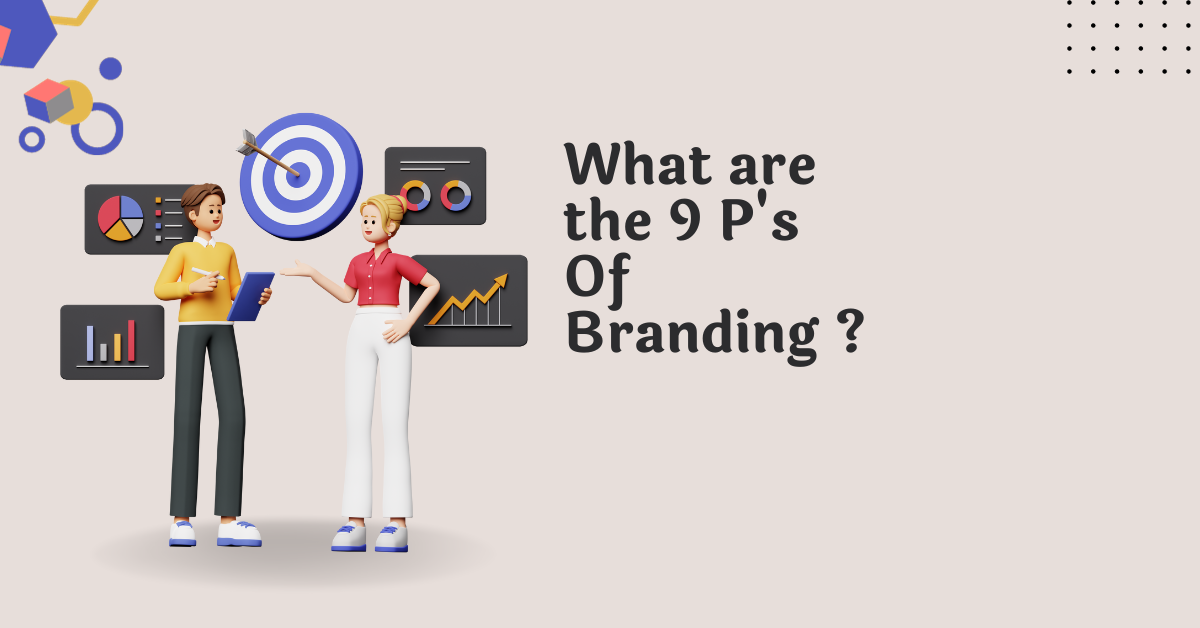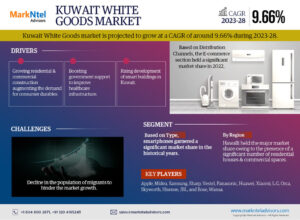
What are the 9 P’s Of Branding ? A Detailed Guide
Branding is a fundamental aspect of marketing and business strategy, encompassing a wide range of elements that collectively create a company’s identity, image, and reputation in the eyes of its target audience. Whether you are a startup or an established corporation, understanding the key elements of branding is essential for building a strong, recognizable, and trustworthy brand. In this comprehensive guide, we will explore the core elements of branding and how they contribute to the success of a business.
1. Logo and Visual Identity
Your logo is often the first thing people associate with your brand. It’s a visual representation of your company and should be instantly recognizable. A well-designed logo is not just an attractive image; it communicates the essence of your brand and its values. Your visual identity, including colors, fonts, and design elements, should be consistent across all brand materials, from your website to your packaging.
A memorable logo and consistent visual identity help customers recall your brand and create a sense of trust and reliability. Think of the Nike swoosh, the Apple apple, or the golden arches of McDonald’s – these logos are etched in our minds.
2. Brand Name
Your brand name is the foundation of your brand. It should be unique, memorable, and relevant to your products or services. Choosing the right name is critical because it’s difficult to change once you’ve established your brand. The name should resonate with your target audience and be easy to spell and pronounce.
Consider the name “Google.” It’s a play on the mathematical term “googol,” representing a vast amount of information – a perfect fit for a search engine. The name sets the tone for the brand’s mission and identity.
3. Tagline or Slogan
A tagline or slogan is a brief and catchy phrase that encapsulates your brand’s essence, values, or promise. It’s a powerful tool for conveying your brand’s message in a memorable way. Nike’s “Just Do It” and McDonald’s “I’m Lovin’ It” are examples of iconic taglines that have become synonymous with their respective brands.
A well-crafted tagline can leave a lasting impression and evoke emotions that connect customers to your brand.
4. Brand Story
Your brand story is the narrative that explains your brand’s origins, mission, and values. It gives your brand a human touch, making it relatable to customers. Sharing the journey of how your brand came into existence, the challenges you’ve overcome, and the purpose behind your products or services can create a strong emotional bond with your audience.
Telling a compelling brand story can differentiate your brand and make it more appealing to consumers seeking a deeper connection with the companies they support.
5. Brand Voice and Tone
Your brand should have a consistent voice and tone in all communication channels, from social media posts to customer service interactions. The way you speak to your audience should align with your brand’s personality and values. Are you formal or casual, serious or lighthearted? Define your brand’s voice and ensure it remains consistent.
For example, the tone of an environmentally conscious brand would likely be serious and informative, while a fun and youthful brand might use a more lighthearted and informal tone.
6. Target Audience
Understanding your target audience is crucial in branding. You need to know who your ideal customers are – their demographics, psychographics, needs, and preferences. Building your brand around the wants and aspirations of your target audience allows you to tailor your messaging, design, and products or services to resonate with them.
Branding that speaks directly to your target audience is more likely to capture their attention and lead to higher conversion rates.
7. Brand Promise
Your brand promise is the commitment you make to your customers. It defines what they can expect from your products or services. This promise should be realistic and achievable, as it sets the foundation for trust. For instance, Volvo’s brand promise revolves around safety, and their reputation for producing safe vehicles has made them a trusted choice for families.
Consistently delivering on your brand promise builds trust and loyalty among your customer base.
8. Brand Positioning
Positioning your brand in the market is about finding a unique spot that sets you apart from competitors. It involves considering how you want consumers to perceive your brand compared to others in the same industry. Are you the most affordable, the most innovative, the most luxurious, or the most environmentally friendly option?
Successful branding defines and maintains a clear and distinct brand positioning in the minds of consumers.
9. Brand Equity
Brand equity is the intangible value of your brand, including its reputation, customer loyalty, and perceived value. Brands with strong equity are more resilient and can command higher prices for their products or services. Consider how Apple’s brand equity allows it to charge premium prices for its products.
Building brand equity takes time and consistent effort but is a key factor in long-term success.
10. Brand Consistency
Consistency is crucial in branding. All the elements mentioned above should work together harmoniously to create a cohesive brand identity. This consistency should extend to every customer touchpoint, from your website and social media profiles to your advertising and customer service interactions.
Inconsistent branding can confuse customers and dilute your brand’s impact.
11. Branding Guidelines
To maintain consistency, many companies create branding guidelines. These are documents that detail how the brand elements should be used and applied. They include specifications for logo usage, color palettes, typography, and design principles. Having these guidelines in place ensures that everyone in your organization and any external partners understand how to represent your brand correctly.
12. Brand Awareness
Brand awareness is the extent to which consumers recognize your brand. It’s crucial to measure and improve brand awareness through various marketing strategies, including advertising, public relations, and social media campaigns. The goal is for your brand to be top-of-mind when consumers think of products or services in your category.
Brand awareness can significantly impact customer acquisition and retention.
13. Brand Loyalty
Building brand loyalty is an ongoing process. Loyal customers are more likely to make repeat purchases, recommend your brand to others, and be forgiving when the occasional hiccup occurs. Exceptional customer service, consistent quality, and a strong emotional connection with your brand contribute to loyalty.
Loyal customers are a valuable asset, as they can become brand advocates.
14. Brand Extensions
Brand extensions involve expanding your brand into new product or service categories. When executed correctly, they can capitalize on your existing brand’s trust and recognition. For example, the Walt Disney Company extended its brand from animation to theme parks, merchandise, and media networks.
However, brand extensions must be carefully planned to ensure they align with your brand’s core values and meet customer expectations.
15. Competitive Analysis
Understanding your competitors is an essential part of branding. Analyze their branding strategies, strengths, weaknesses, and how they position themselves in the market. By doing so, you can identify opportunities to differentiate your brand and capture market share.
A strong brand should be distinct from the competition and offer unique value.
16. Rebranding
Rebranding is the process of updating or changing your brand’s identity, often because of shifts in the market, changes in the company’s mission, or a need to modernize. Rebranding can be a risky endeavor, as it can alienate existing customers, but when done well, it can revitalize a brand and attract new audiences.
Rebranding should be a thoughtful, strategic decision, not a hasty one.
17. Branding Metrics
To gauge the effectiveness of your branding efforts, you need to establish key performance indicators (KPIs) and regularly measure your brand’s performance. Metrics like brand awareness, customer sentiment, customer lifetime value, and Net Promoter Score (NPS) can provide valuable insights into how your brand is perceived and whether it’s achieving its goals.
Monitoring these metrics allows you to make data-driven decisions to refine your branding strategies.
18. Social Responsibility
In today’s socially conscious world, consumers often align with brands that demonstrate a commitment to social responsibility. Brands that support environmental causes, community initiatives, or ethical sourcing can enhance their reputation and appeal to a broader audience.
Social responsibility is not just a moral choice; it’s a strategic branding element that can set your brand apart.
19. Innovation
Innovation is a powerful element of branding, especially in industries where constant evolution is the norm. Brands that consistently introduce new and improved products or services can position themselves as industry leaders. Apple, for instance, is renowned for its innovative approach to technology.
Innovation not only attracts new customers but also keeps existing ones engaged and excited.
20. Visual Elements
Beyond the logo and visual identity, your brand’s visual elements include images, graphics, and design elements used in marketing materials, advertisements, and on your website. These visual elements should be in harmony with your brand’s style and values. They play a significant role in creating a visual impression of your brand.
21. Online Presence
In the digital age, your online presence is a critical aspect of branding. Your website, social media profiles, and online content should reflect your brand’s identity and values. Consistency across these platforms helps build trust and recognition with your online audience.
22. Customer Experience
The overall experience your customers have with your brand is a fundamental element of branding. From the moment a customer visits your website to the post-purchase support they receive, every interaction shapes their perception of your brand. Exceptional customer experiences can set your brand apart in a crowded marketplace.
23. Packaging
If you sell physical products, packaging is a key branding element. It’s the first tangible interaction customers have with your brand. Effective packaging not only protects your products but also communicates your brand’s values and identity.
24. Brand Associations
Your brand can benefit from associations with other brands, influencers, or causes. For example, a clothing brand might collaborate with a popular influencer, enhancing its appeal to the influencer’s followers. These associations can help expand your reach and align your brand with specific values or audiences.
25. Emotional Appeal
Effective branding should evoke emotions. A strong brand connects with customers on a deeper level, resonating with their values and desires. Whether it’s a sense of nostalgia, trust, excitement, or comfort, the emotions your brand evokes play a significant role in customer loyalty.
26. Storytelling
Telling your brand’s story is not limited to a single instance; it should be an ongoing narrative. Effective storytelling keeps your brand relevant and relatable to your audience. It allows your customers to connect with your brand on a personal level and feel like a part of your journey.
27. Cultural Sensitivity
In an increasingly diverse and global marketplace, brands need to be culturally sensitive. Understanding and respecting the cultures and beliefs of your target audience is crucial to avoid inadvertently alienating potential customers.
28. Content Strategy
Your content strategy is a vital part of branding. The content you create, whether it’s blog posts, videos, social media updates, or podcasts, should align with your brand’s message and values. It should also provide value to your audience, positioning your brand as an authority in your industry.
29. Crisis Management
Unforeseen crises can impact your brand’s reputation. Being prepared with a crisis management plan and effectively handling negative situations can minimize damage and protect your brand’s integrity. Transparency and open communication are essential in managing crises.
30. Consistency in Advertising
Your advertising campaigns should align with your brand’s message and values. Consistency in advertising helps reinforce your brand’s identity in the minds of consumers. Whether it’s TV commercials, online ads, or print media, the messaging and imagery should all reflect your brand’s core principles.
31. Feedback and Listening
Listening to customer feedback is an ongoing element of branding. It helps you understand what your customers like and dislike about your brand and allows you to make improvements. Encouraging feedback and addressing customer concerns can foster goodwill and loyalty.
32. Packaging and Presentation
Your products’ packaging and presentation should be designed to create a positive impression. This is particularly important for luxury and premium brands, where the packaging itself can be seen as a status symbol.
33. Trademarks and Intellectual Property
Protecting your brand through trademarks and other forms of intellectual property is essential. This ensures that others cannot copy or imitate your brand’s elements, safeguarding your brand’s uniqueness and integrity.
34. Employee Brand Alignment
Your employees are brand ambassadors. They should understand and embody your brand’s values and mission. Consistent brand alignment from the inside out helps ensure that every customer interaction reflects your brand’s identity positively.
35. Personal Branding
In some cases, individuals within a company can become personal brands. This can enhance the overall brand’s reputation and recognition. Personal branding, often seen in the context of CEOs or founders, can bring a human element to your brand.
36. Measuring and Adjusting
Branding is not static; it evolves over time. Regularly measuring the effectiveness of your branding efforts and making necessary adjustments is crucial. What worked well in the past may not be as effective in the future, so staying adaptable is key to maintaining a strong brand.
Read More :- Best Digital Marketing Agency in Noida
Conclusion
In the competitive world of business, effective branding is a dynamic and multifaceted process. It involves creating a unique identity, connecting with your target audience, and consistently delivering on your brand promise. By considering and incorporating these elements of branding, you can build a strong, enduring brand that resonates with customers and stands out in the market. Remember, successful branding is not just about what you say but also about how you make your customers feel.



